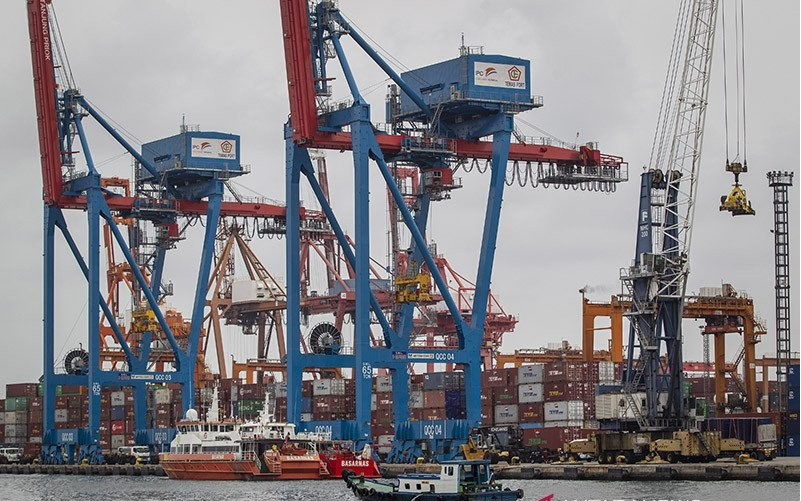Popular Reads
Top Results
Can't find what you're looking for?
View all search resultsPopular Reads
Top Results
Can't find what you're looking for?
View all search resultsData driven supply chain: Leaders or laggards?
Through data analytics and connected intelligence, customer behavior patterns and insights will emerge alongside any inefficiencies, potential supply bottlenecks and shortages.
Change text size
Gift Premium Articles
to Anyone
E
veryone should still remember the toilet roll crisis at the beginning of the pandemic. Supply chain seems to be “invisible” when you can get what you want at the time you want them. But, when things go wrong, it gets the blame for everything.
A once-complex and multi-stakeholder supply chain that gets food on the table or products and components to factories and distribution centers has been under severe threat after the world was forced to pivot to digital in 2020.
How do suppliers, manufacturers and retailers keep their customers and their employees happy, yet at the same time be productive and thrive in this new normal?
In today’s data-driven world, a rethink is necessary to optimize supply chain. Instead of a linear supply “chain”, a more accurate perspective would be to consider it a sophisticated, multi-dimensional, dynamic and often global, real-time entity that moves and reacts to every small change in any number of variables.
A “supply amoeba” if you like, that connects all the suppliers, manufacturers, distributors, warehouses and retailers on different timelines and dimensions but all working to the same single purpose – meet the expectations of an increasingly demanding customers' base in a shifting and dynamic market. All of these rely on accurate data to make intelligent decisions.
But what has changed?
The objective remains the same but today, the expectations we have in the modern supply chain are quite different. Technology has upped the ante, thanks to the millennials, and expectations on personalization and speed-to-market have never been higher than now.
At the same time, through Internet of Things (IoT) sensors, data at scale technologies, robotics and blockchain, every step of a product’s journey generates data, every participant generates data. As exciting as it all sounds, the modern-day supply chain is riddled with operational and fundamental challenges that impact different perspectives in the supply chain ecosystem.
In this context, it is easy to grasp the sheer amount of data that is being generated and, from that, the enormous opportunities if it can be accessed and used effectively. At the same time, there is every likelihood that this information is recorded and stored in silos, which rule out any ability to share, access and produce valuable insights.
This is made even worse by all the platforms, applications, devices and even partner organizations that generate and collect data in different formats in different rules all along the supply chain, making full visibility almost impossible.
While the task of integrating all this raw information may seem daunting, there are solutions on hand that will enable an organization to overcome the issues and deliver an end-to-end view of their information. This effectively provides them with a virtual model, or a “digital twin” of the entire supply chain and all its associated processes.
This pairing of the virtual and physical worlds allows analysis of data and monitoring of systems to head off problems before they even occur, prevent downtime, develop new opportunities and even plan for the future by using simulations.
Analytics and data-driven insights allow sales and operations to optimize production and distribution capacity. Through direct-to-customer communications channels, market insights like buying and demand signals can give feedback to escalate production or even reallocate distribution.
For retailers, a data driven intelligent supply chain ensures a balance between meeting dynamic demand cycles and pre-empting an oversupply of goods and produce. By digitizing and collecting data throughout the product journey, organizations can build a transparent and resilient supply chain that behaves and acts more like a living entity than a linear process.
The key to success in building a digitized supply chain is collecting data at source; from IoT devices, data exchanges, transactional systems, inventory management applications, as well as supplier, partner and consumer interactions. Through successful integration, all this becomes available for analysis in real time.
Through data analytics and connected intelligence, customer behavior patterns and insights will emerge alongside any inefficiencies, potential supply bottlenecks and shortages. Organizations can view what is running behind schedule and identify any risks associated with over-reliance on single sources and suppliers.
Data gives enterprise-wide teams insights into how much waste is produced, if quality and regulatory standards are being met and how to optimize production. By checking quality at every stage, quality teams can detect issues early and avoid the cost of wastage and pre-empt any reputational damage.
During any disruption, such as the pandemic, a deep understanding of the current and future logistics requirements is essential as it allows goods to be re-routed to avoid any congestion in the ports or issues of border controls and hold ups. In this way they can stay on target with customer fulfilment.
In short, a data driven supply chain delivers real-time visibility, as well as more predictable and adaptable fulfilment. It also enables the management of inventory levels in response to changes via rapid detection, understanding and response to exceptions. Advanced technologies including visual analytics, data science, streaming applications, data virtualization and integration all work together to create a seamless, intelligent supply chain. Smart operators will make full use of all the data generated to simplify their business processes and reduce operating costs.
The challenges of the pandemic should be seen as opportunities in disguise. By confronting potential issues systematically, organizations now have new avenues to enhance services and improve business outcomes through a supply chain that is resilient, predictable and scalable.
If organizations fail to invest in better integration of their data and seize the benefits of advanced analytics solutions, they will be left in the wake of their competitors, trying to operate on supply chains that are not fit for purpose.
***
The writer is senior vice president for Europe, the Middle East, Africa, Asia Pacific and Japan at TIBCO Software Inc.











